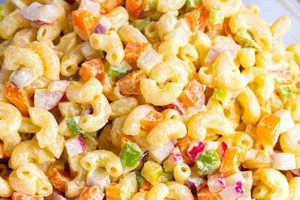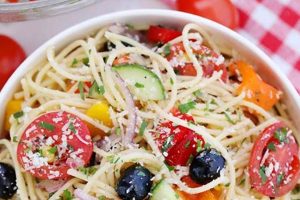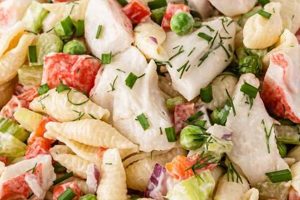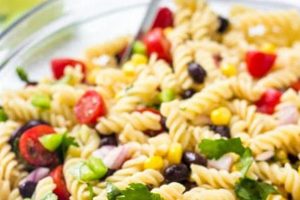A vibrant and flavorful chilled dish, this culinary creation typically combines cooked pasta, such as rotini or farfalle, with a medley of cured meats like salami and pepperoni, cheeses like provolone and mozzarella, marinated vegetables like artichoke hearts and olives, and a tangy vinaigrette. Variations often include other ingredients like pepperoncini, roasted red peppers, or fresh herbs. This cold pasta dish offers a convenient and customizable approach to entertaining, serving as a complete meal or a substantial side.
The appeal lies in its versatility and adaptability. It’s an ideal make-ahead dish for picnics, potlucks, and gatherings, requiring minimal preparation time just before serving. The combination of textures and flavors the chewiness of the pasta, the saltiness of the meats and cheeses, the tang of the vegetables, and the brightness of the vinaigrette creates a satisfying and well-balanced culinary experience. This dish also offers an opportunity to utilize leftover cooked pasta and incorporate seasonal vegetables, promoting both creativity and reduced food waste. Historically inspired by the Italian tradition of antipasto, which comprises an assortment of appetizers, this dish translates the concept into a convenient and cohesive single serving.
Further exploration will delve into specific variations, ingredient selection considerations, preparation techniques, and tips for optimal presentation and serving.
Tips for Creating an Excellent Antipasto Pasta Salad
Careful consideration of ingredients and preparation techniques elevates this dish from simple to exceptional. The following tips offer guidance for achieving optimal flavor and texture.
Tip 1: Pasta Selection: Short, sturdy pasta shapes like rotini, farfalle, or penne hold their shape well and capture the dressing effectively. Avoid long, thin noodles, which can become tangled and difficult to manage.
Tip 2: High-Quality Ingredients: Opt for high-quality cured meats, cheeses, and olives. Fresh mozzarella provides a softer texture than block mozzarella, while premium salami or prosciutto contributes richer flavor.
Tip 3: Vegetable Variety: Incorporate a variety of marinated vegetables artichoke hearts, roasted red peppers, pepperoncini, and olives to create a balance of flavors and textures.
Tip 4: Vinaigrette Balance: Use a tangy vinaigrette that complements the other ingredients. A simple red wine vinaigrette or a lemon-herb vinaigrette works well. Avoid overly creamy dressings, which can weigh down the salad.
Tip 5: Marination Time: Allow the salad to marinate in the refrigerator for at least 30 minutes before serving. This allows the flavors to meld and the pasta to absorb the dressing.
Tip 6: Fresh Herbs: Incorporate fresh herbs like basil, oregano, or parsley just before serving to add brightness and aroma.
Tip 7: Serving Temperature: Serve chilled but not ice cold, allowing the flavors to fully develop.
By following these tips, one can create a flavorful, visually appealing, and satisfying dish that complements any occasion.
These guidelines provide a foundation for crafting a successful dish. Experimentation with ingredients and flavors is encouraged to develop personalized variations.
1. Pasta Shape
Pasta shape plays a crucial role in the overall success of an Italian antipasto pasta salad. The chosen shape affects not only the aesthetics of the dish but also its functionality, specifically how well it holds the dressing and interacts with the other ingredients. Short, sturdy pasta shapes, such as rotini, farfalle (bowties), or penne, are generally preferred. Their compact structure prevents them from becoming overly soggy or breaking apart when mixed with the vinaigrette and other components. These shapes also offer crevices and folds that effectively capture the dressing, ensuring that each bite delivers a balanced flavor profile.
Conversely, long, thin pasta shapes like spaghetti or linguine are less suitable. Their delicate structure makes them prone to breakage during mixing, resulting in a less appealing presentation. They also tend to clump together, making it difficult to achieve an even distribution of ingredients and dressing. Imagine trying to combine long strands of spaghetti with chunky vegetables and cured meats; the result would be a cumbersome and visually unappealing salad. Rotini, on the other hand, with its spirals, readily intermingles with the other ingredients, creating a harmonious and flavorful blend.
Therefore, selecting an appropriate pasta shape is a key consideration in crafting a successful Italian antipasto pasta salad. The choice directly impacts the dish’s texture, appearance, and ability to effectively showcase the diverse flavors of the other ingredients. Opting for short, sturdy pasta contributes significantly to a more enjoyable and aesthetically pleasing culinary experience.
2. Ingredient Quality
Ingredient quality significantly impacts the overall flavor profile and enjoyment of an Italian antipasto pasta salad. Utilizing premium components elevates the dish from simple to exceptional, delivering a more nuanced and satisfying culinary experience. The selection of each element, from cured meats and cheeses to vegetables and olives, contributes to the final result.
- Cured Meats
Opting for high-quality salami, pepperoni, or prosciutto contributes significantly to the depth of flavor. Generic deli meats often lack the complexity and richness found in artisanal or specialty varieties. For instance, thinly sliced prosciutto offers a delicate saltiness and subtle sweetness, while soppressata provides a more robust, spicy flavor. The quality of cured meats directly influences the overall taste and enjoyment of the salad.
- Cheeses
Cheese selection is equally crucial. Fresh mozzarella, with its creamy texture and mild flavor, provides a pleasant contrast to the saltiness of the cured meats. Using high-quality provolone or aged Parmesan adds depth and complexity. Consider the interplay of flavors and textures when selecting cheeses. For example, a sharp provolone adds a piquant note, while a milder mozzarella balances the stronger flavors.
- Vegetables
Marinated vegetables like artichoke hearts, roasted red peppers, and olives contribute brightness and acidity. High-quality marinated artichoke hearts possess a tender texture and distinct flavor, unlike those packed in excessive oil or brine. Selecting flavorful olives, such as Castelvetrano or Kalamata, further enhances the complexity of the salad.
- Vinaigrette
Even the vinaigrette benefits from quality ingredients. A simple vinaigrette crafted with extra virgin olive oil and a good quality vinegar, such as balsamic or red wine vinegar, provides a more nuanced flavor than pre-made dressings. Freshly squeezed lemon juice can also add a vibrant citrus note.
The cumulative effect of using high-quality ingredients in an Italian antipasto pasta salad is substantial. Each component contributes to the overall flavor profile, resulting in a more balanced and satisfying dish. By prioritizing quality, one elevates the salad from a simple combination of ingredients to a truly exceptional culinary creation.
3. Vinaigrette Selection
Vinaigrette selection plays a pivotal role in the overall balance and flavor profile of an Italian antipasto pasta salad. The vinaigrette acts as a unifying element, binding the diverse ingredients while contributing its own distinct character. A thoughtfully chosen vinaigrette complements the flavors of the cured meats, cheeses, and vegetables, enhancing rather than overpowering them. The interplay of acidity, sweetness, and herbaceous notes within the vinaigrette creates a harmonious backdrop for the other components.
For instance, a classic red wine vinaigrette, with its tangy acidity and subtle fruitiness, provides a counterpoint to the richness of salami and provolone. The acidity cuts through the fattiness of the meats and cheeses, preventing the salad from feeling heavy. Alternatively, a lemon-herb vinaigrette, with its bright citrus notes and aromatic herbs, complements the flavors of marinated vegetables and olives. The herbaceous notes add a layer of complexity, while the lemon juice provides a refreshing lift. A balsamic vinaigrette, with its complex sweetness and subtle tang, offers another dimension, particularly when paired with roasted red peppers or artichoke hearts. The balsamic vinegar’s sweetness harmonizes with the natural sweetness of the vegetables, creating a balanced and flavorful combination.
Selecting an appropriate vinaigrette involves considering the specific ingredients within the salad. A vinaigrette that complements one set of ingredients might clash with another. Therefore, careful consideration of flavor profiles and potential interactions is essential. The goal is to create a cohesive and harmonious blend of flavors, where each component contributes to the overall enjoyment of the dish. Overly creamy or heavy dressings should generally be avoided, as they can mask the individual flavors of the other ingredients and weigh down the salad. A light and vibrant vinaigrette allows the other components to shine while contributing its own distinct character.
4. Marination Time
Marination time plays a critical role in the development of flavor and texture within an Italian antipasto pasta salad. This process allows the vinaigrette to permeate the pasta and other ingredients, melding the individual flavors into a cohesive whole. The duration of marination directly impacts the final outcome, influencing both the intensity of flavor and the texture of the components. Sufficient marination time allows the pasta to absorb the vinaigrette, preventing a bland or dry salad. It also softens the vegetables, mellowing any harsh flavors and creating a more harmonious blend.
Consider a scenario where an antipasto pasta salad is assembled and immediately served. The pasta, while coated in vinaigrette, retains its individual flavor, separate from the other components. The vegetables, particularly those with a naturally assertive flavor like pepperoncini or olives, might taste overly sharp. The cured meats remain distinct, their flavors not yet integrated with the other elements. However, if the same salad is allowed to marinate for at least 30 minutes, a transformation occurs. The pasta absorbs the vinaigrette, taking on the nuanced flavors of the herbs, spices, and oil. The vegetables soften, their flavors mellowing and integrating with the other ingredients. The cured meats, now infused with the vinaigrette, contribute their saltiness and richness to the overall composition.
The practical significance of understanding marination time lies in the ability to optimize the flavor and texture of the final dish. While a minimum of 30 minutes is generally recommended, the ideal marination time may vary depending on the specific ingredients and the intensity of the vinaigrette. Over-marination, however, can lead to soggy pasta and overly softened vegetables. Therefore, finding the appropriate balance is crucial for achieving optimal results. A well-marinated Italian antipasto pasta salad exhibits a harmonious blend of flavors, where the individual components contribute to a unified and satisfying culinary experience. The pasta is infused with the vinaigrette, the vegetables are tender yet retain their structure, and the cured meats and cheeses contribute their characteristic flavors to the overall composition. This understanding of marination’s impact allows for precise control over the final outcome, ensuring a flavorful and texturally pleasing dish.
5. Fresh Herbs
Fresh herbs contribute a vibrant and aromatic dimension to Italian antipasto pasta salad, elevating its flavor profile beyond the foundational ingredients. Their inclusion introduces a layer of complexity, brightness, and freshness that complements the richness of cured meats, cheeses, and marinated vegetables. Careful selection and application of fresh herbs enhance the overall sensory experience, transforming a simple pasta salad into a more nuanced and flavorful dish.
- Aromatic Enhancement
Fresh herbs impart distinctive aromas that complement and enhance the existing flavors within the salad. Basil, with its sweet, slightly peppery aroma, pairs well with mozzarella and tomatoes. Oregano, possessing a pungent, earthy aroma, complements olives and marinated vegetables. Parsley, with its clean, fresh scent, provides a versatile backdrop for a variety of ingredients. These aromatic notes create a more complex and engaging sensory experience.
- Flavor Balancing
Fresh herbs contribute not only aroma but also flavor. The slight bitterness of basil balances the richness of cured meats. The peppery notes of oregano complement the saltiness of olives and cheeses. The subtle, grassy flavor of parsley provides a refreshing counterpoint to the heavier elements within the salad. This interplay of flavors creates a more balanced and harmonious profile.
- Visual Appeal
The vibrant green hues of fresh herbs enhance the visual appeal of the salad, adding a touch of brightness and freshness. Sprinkling chopped parsley, basil, or oregano over the finished dish creates a more inviting and aesthetically pleasing presentation. This visual element adds to the overall enjoyment of the culinary experience.
- Timing of Incorporation
To maximize their impact, fresh herbs are typically added just before serving. This preserves their delicate flavors and aromas, which can be diminished by prolonged exposure to the vinaigrette and other ingredients. Incorporating fresh herbs at the final stage ensures their vibrancy and contributes to a more impactful sensory experience. For example, adding chopped basil just before serving allows its sweet, peppery notes to shine through without being overwhelmed by the other flavors.
The strategic use of fresh herbs in an Italian antipasto pasta salad elevates the dish from simple to sophisticated. Their aromatic and flavor contributions create a more complex and balanced profile, while their visual appeal enhances the overall presentation. By understanding the role and impact of fresh herbs, one can create a more nuanced and satisfying culinary experience. The careful selection and application of these herbs contribute significantly to the final product, showcasing the potential for even simple ingredients to create a dish that is both flavorful and visually appealing.
6. Serving Temperature
Serving temperature significantly influences the overall sensory experience of an Italian antipasto pasta salad. Temperature affects both the perception of flavor and the textural components of the dish. Serving the salad at the optimal temperature enhances the interplay of flavors and textures, creating a more balanced and enjoyable culinary experience. An excessively cold salad can dull the nuanced flavors of the cured meats, cheeses, and marinated vegetables. Conversely, serving the salad at room temperature can compromise the freshness and textural integrity of the ingredients, potentially leading to a less appealing and less safe culinary experience.
Consider the impact of temperature on individual components. The delicate flavors of fresh mozzarella are more pronounced when served slightly chilled rather than ice cold. The subtle sweetness of roasted red peppers is enhanced at a moderate temperature, allowing the nuanced flavors to emerge fully. The crispness of fresh vegetables, like bell peppers or cucumbers, is compromised at warmer temperatures, resulting in a less satisfying textural contrast. Cured meats, such as salami or prosciutto, can become overly greasy and lose their distinct flavors when served at room temperature.
Practical application of this understanding lies in chilling the salad thoroughly but avoiding excessive coldness. Removing the salad from the refrigerator approximately 30 minutes before serving allows the flavors to develop fully while maintaining the desired coolness. This approach balances the need for food safety with the desire for optimal flavor and texture. The ideal serving temperature enhances the interplay of flavors, highlighting the individual characteristics of each ingredient while creating a harmonious and refreshing culinary experience. Attention to serving temperature demonstrates an understanding of the nuanced interplay of temperature and flavor, elevating the enjoyment of this classic dish.
Frequently Asked Questions
This section addresses common inquiries regarding the preparation and enjoyment of Italian antipasto pasta salad.
Question 1: Can this dish be prepared in advance?
Yes, this dish is well-suited for advance preparation. In fact, allowing the salad to marinate for a period enhances flavor development. However, adding fresh herbs just prior to serving is recommended to preserve their vibrancy.
Question 2: What are suitable pasta alternatives for gluten-free diets?
Gluten-free pasta options, such as those made from rice, corn, or quinoa, can be substituted. It’s essential to select shapes that hold their structure well during marination.
Question 3: How long can the salad be stored in the refrigerator?
Properly stored in an airtight container, the salad can be refrigerated for up to three days. Consume within this timeframe for optimal quality and food safety.
Question 4: Can the ingredients be customized?
This dish offers significant flexibility. Ingredients can be adapted based on dietary preferences and seasonal availability. Consider variations incorporating different vegetables, cheeses, or cured meats.
Question 5: What vinaigrette alternatives exist for those avoiding oil?
A light vinaigrette using lemon juice or vinegar as a base can replace oil-based versions. Herbs and spices can be added to enhance flavor complexity.
Question 6: Is this dish suitable for vegetarian diets?
Omitting the cured meats and incorporating additional vegetables or plant-based protein sources, such as chickpeas or white beans, creates a suitable vegetarian adaptation.
Understanding these considerations ensures successful preparation and enjoyment of Italian antipasto pasta salad, adaptable to various preferences and dietary needs.
This concludes the frequently asked questions section.
Italian Antipasto Pasta Salad Recipe
Exploration of this classic dish reveals its adaptability and enduring appeal. Careful consideration of pasta shape, ingredient quality, vinaigrette selection, marination time, fresh herb incorporation, and serving temperature contributes significantly to the final product. From the structural integrity of rotini to the nuanced flavors of high-quality cured meats and cheeses, each element plays a crucial role in the overall sensory experience. The balance of acidity and flavor in the vinaigrette, the melding of flavors during marination, and the vibrant freshness of herbs all contribute to the dish’s complexity. Serving temperature considerations further refine the experience, ensuring optimal flavor expression and textural enjoyment.
This dish represents more than a simple combination of ingredients; it embodies a culinary tradition, adaptable to individual preferences and dietary needs. Its versatility and capacity for customization ensure its continued presence in culinary landscapes, offering a refreshing and flavorful experience for both novice cooks and seasoned chefs. The ongoing exploration of flavor combinations and ingredient variations promises a vibrant future for this classic dish.






